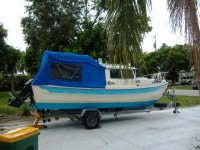Captains Cat
New member
- Joined
- Nov 3, 2003
- Messages
- 7,313
- Reaction score
- 1
- C Dory Year
- 2005
- C Dory Model
- 22 Cruiser
- Hull Identification Number
- CDO22289L405
- Vessel Name
- Captain's Choice II
Hey Matt, probably too late for this year but John on Swee Pea (see his album page 4/5) used a G&G Boat Lift to get the trailer out from under his 22.
Probably not strong enough for a TC255 but I bet you could build one strong enough for it without too much effort. Would sure make painting the bottom simple without the trailer there at all. The twin hulls would make it very stable while moving the trailer out.
Charlie
Probably not strong enough for a TC255 but I bet you could build one strong enough for it without too much effort. Would sure make painting the bottom simple without the trailer there at all. The twin hulls would make it very stable while moving the trailer out.
Charlie

